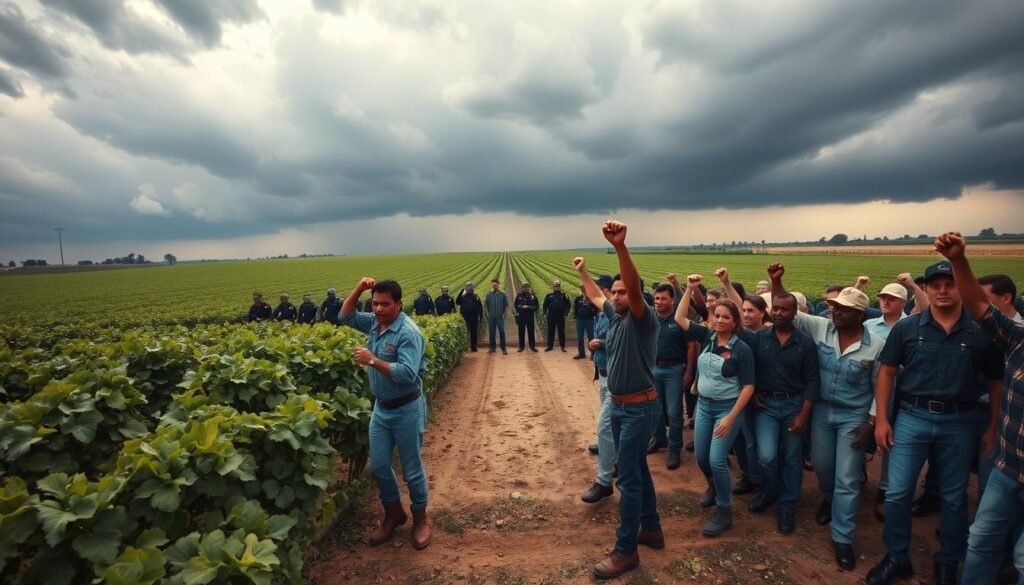What if one person could change the lives of millions of farm workers and inspire generations of activists? Dolores Huerta did exactly that through her tireless work and unwavering commitment to justice.
Born in 1930 in New Mexico, Huerta grew up witnessing discrimination in her community. Her mother’s activism and her own teaching experience showed her the struggles facing working families.
She co-founded the United Farm Workers with Cesar Chavez, organizing the famous Delano grape strike. Her work brought national attention to farm workers’ rights and poor working conditions.
Huerta created the powerful slogan “sí se puede” (yes we can) that became a rallying cry for workers everywhere. She fought for better pay, safer conditions, and dignity for all laborers.
Her activism extended beyond labor rights to include voter registration and feminist causes. Even today, she continues to inspire new generations through her foundation’s work.
Key Takeaways
- Dolores Huerta co-founded the United Farm Workers organization
- She organized the historic Delano grape strike in 1965
- Huerta created the famous “sí se puede” slogan
- She fought against discrimination and for workers’ rights
- Her activism continues to inspire communities today
- She received the Presidential Medal of Freedom in 2012
- Huerta’s work expanded to include voter registration efforts
Dolores Huerta: Early Life and Influences
The foundation of a remarkable activist’s journey often begins in childhood experiences that shape their worldview. For this influential labor leader, formative years in the American Southwest laid the groundwork for a lifetime of advocacy.
Birth and Family Background
Born Dolores Fernández on April 10, 1930, in Dawson, New Mexico, she entered a world of working-class values. Her father Juan Fernández worked as a coal miner and held union membership, later serving as a state legislator. This early exposure to labor organizing and political engagement would prove significant.
Her parents divorced when she was young, creating a shift in family dynamics. Her mother Alicia Chávez demonstrated remarkable resilience during this challenging period.
Childhood in New Mexico and California
Alicia moved the family to Stockton, California, seeking better opportunities. They settled in a diverse, integrated neighborhood that exposed young Dolores to various cultures and backgrounds.
Her mother worked multiple jobs to support the family, including work as a canner and waitress. Later, Alicia became a business owner, operating a restaurant and hotel. These experiences showed the value of hard work and entrepreneurship.
Alicia’s activism deeply influenced her daughter’s developing values. She participated in strikes and supported community causes, modeling compassion and social engagement. This maternal example planted early seeds of justice advocacy.
Early Experiences with Discrimination
School years brought painful encounters with prejudice. Teachers sometimes accused her of cheating due to her Hispanic heritage, creating early awareness of unfair treatment.
Racial violence touched her family directly when her brother was beaten for wearing a Zoot-Suit. This incident highlighted the dangerous realities of discrimination in their community.
Despite these challenges, she remained active in organizations like the Girl Scouts. She attended Stockton High School, graduating in 1947 as a dedicated student.
Her personal life included an early marriage to Ralph Head and the birth of her first two children. After divorcing, she pursued education at San Joaquin Delta College, earning a teaching credential in 1953.
These early experiences forged a strong commitment to social justice and workers’ rights. Witnessing the hardships of farm workers’ children during her teaching years would ultimately propel her toward activism, setting the stage for her remarkable career as a labor leader and civil rights advocate.
Education and Formative Years
Sometimes the most profound lessons about injustice are learned not from textbooks, but from observing students’ daily struggles. This proved true for the young educator whose classroom experiences would redirect her life’s work toward labor organizing.
Schooling and Teaching Career
After graduating from Stockton High School in 1947, she earned a provisional teaching credential from San Joaquin Delta College. Her education prepared her for a brief but impactful teaching career beginning in 1954.
She became one of the few bilingual teachers in rural California schools. This unique position allowed her to connect deeply with her students and their families.
The classroom revealed harsh realities about her students’ living conditions. Many children of farm workers arrived hungry and wore inadequate clothing despite cold weather.
Decision to Pursue Activism
Witnessing this severe poverty among her students became unbearable after just one year of teaching. She realized that individual classroom efforts couldn’t address systemic issues affecting farm workers’ families.
This formative period solidified her commitment to labor rights and community organizing. She made the difficult decision to leave her stable teaching career for uncertain activism work.
Her teaching experience directly informed her future advocacy for better working conditions. She understood that organizing workers could create change more effectively than classroom teaching alone.
This transition prepared her for subsequent work with the Community Service Organization. The educational and economic disparities she witnessed would fuel her activism for decades to come.
Community Service Organization (CSO) Activism
Organizing for change often begins with one person’s decision to transform their community. This pivotal moment arrived when a determined activist met Fred Ross in 1955.
Initially skeptical of Ross’s organizing methods, she quickly recognized their power. Her commitment to the CSO grew as she saw its potential for creating real change.
Founding the Stockton Chapter
She co-founded the Stockton chapter, starting with traditionally feminine roles. These early tasks included administrative work and community outreach.
Her leadership abilities soon emerged despite these initial assignments. She demonstrated remarkable skill in mobilizing local residents around common issues.
Voter Registration and Advocacy Work
Voter registration drives became a cornerstone of her work. She recognized political power as essential for community advancement.
Her advocacy extended to economic improvements for Hispanic residents. She lobbied for retirement benefits for noncitizens and health coverage for farm workers.
She passionately opposed the Bracero Program, testifying before the California State Legislature. Her testimony highlighted the program’s exploitation of migrant workers.
Citizenship classes became another important initiative. She taught new Americans about their rights and responsibilities.
Neighborhood improvement projects showed her practical approach to activism. These efforts directly enhanced living conditions in local communities.
During these years, she met Cesar Chavez through the CSO network. This meeting would later prove historic for the labor movement.
Her personal life included marriage to Ventura Huerta during this period. Together they had five children while she continued her activist work.
The CSO provided crucial training in organizing and negotiation techniques. These skills would later prove invaluable in farm labor activism.
While the organization focused on urban issues, she grew increasingly concerned about farm workers’ conditions. This frustration with the CSO’s limitations would eventually lead her to seek more direct action for agricultural laborers.
Her voter registration efforts significantly impacted Hispanic communities in Stockton. Thousands gained political voice through her determined work over several years.
Co-Founding the National Farm Workers Association (NFWA)
When existing structures fail to address critical needs, visionary leaders create new pathways for change. This pivotal moment arrived in 1962 when the labor activist made a courageous decision to leave the Community Service Organization.
The CSO’s urban focus limited its impact on agricultural workers. Rural laborers faced terrible conditions with little support from existing groups.
Partnership with Cesar Chavez
She joined forces with Cesar Chavez and Gilbert Padilla to build something new. Each brought unique strengths to this historic partnership.
Chavez provided inspirational leadership and strategic vision. Padilla contributed grassroots organizing experience from field work.
The co-founder handled critical operational tasks despite financial hardship. She made phone calls, collected dues, and visited worker camps regularly.
Money was extremely tight during these early years. She took extra jobs as a translator and substitute teacher to support her family.
Goals and Early Organizing Efforts
The NFWA had clear objectives from the beginning. Better wages and improved working conditions topped their priority list.
They sought collective bargaining rights for agricultural laborers. This would give workers real power in negotiations.
Early efforts included the 1965 strike for rose grafters. This action resulted in wage increases but no formal contract.
Internal conflicts and grassroots mobilization challenges tested their resolve. Building trust among skeptical workers required persistent effort.
The organization moved its headquarters to Delano for strategic reasons. This placed them at the heart of agricultural regions.
This relocation set the stage for larger actions to come. The NFWA would soon evolve into a major force for labor rights.
These foundational years established the organizing principles that would define the farm workers movement. The partnership’s complementary skills created a powerful foundation for change.
The Delano Grape Strike of 1965
When workers unite across ethnic lines to demand dignity, they can achieve what seemed unattainable. The 1965 grape strike became such a moment, transforming labor relations in American agriculture forever.
Initiation and Key Events
Filipino farm workers began the historic action on September 8, 1965. Larry Itliong’s Agricultural Workers Organizing Committee led the initial walkout.
The National Farm Workers Association joined eight days later. This created a powerful multi-ethnic coalition of laborers.
Thousands of workers left vineyards across California’s Central Valley. They demanded better pay and improved working conditions.

The strike lasted an incredible five years, testing everyone’s resolve. Growers used various tactics to break the movement.
Police arrested hundreds of picketers throughout the conflict. Despite these challenges, the strikers maintained their unity.
Huerta’s Role in Boycott Campaigns
The labor leader organized nationwide consumer boycotts that proved crucial. She initially worked in California before moving east.
New York and New Jersey became key battlegrounds for her efforts. She picketed major grocery chains including A&P stores.
Her fiery speeches mobilized diverse communities behind the cause. Churches, unions, and student groups joined the boycott.
She faced legal challenges under the Taft-Hartley Act’s restrictions. Despite this, her secondary boycott strategies proved highly effective.
Retailers gradually stopped carrying non-union grapes due to public pressure. This economic pressure forced growers to negotiate.
The two organizations merged during the strike year, forming the United Farm Workers. She became vice president of this new union.
Contract negotiations with major companies like Schenley and Gallo followed. These talks resulted in significant improvements for workers.
The five-year struggle concluded with historic contracts guaranteeing better wages. Health benefits and pesticide protections were also secured.
This victory empowered agricultural workers like never before. It demonstrated the power of strategic organizing and consumer activism.
Formation of the United Farm Workers (UFW)
True power emerges when separate forces unite behind a common purpose. The year 1965 marked a historic moment when two agricultural organizations joined to create a stronger voice for field laborers.
Merger with AWOC
The Agricultural Workers Organizing Committee (AWOC) and National Farm Workers Association (NFWA) merged their efforts. This collaboration brought together Filipino and Mexican American farm workers under one banner.
Larry Itliong’s AWOC had initiated the grape strike that sparked the movement. Cesar Chavez’s NFWA joined the action eight days later, creating unprecedented solidarity.
The new organization became the United Farm Workers Organizing Committee. It later shortened its name to the United Farm Workers (UFW). This merger created a powerful, multi-ethnic labor union.
Huerta as Vice President and Negotiator
Dolores Huerta received the vice president position in the new union. Her appointment recognized her crucial organizing work and strategic abilities.
She became the UFW’s primary contract negotiator with major companies. Her first significant achievement came with Schenley Industries in 1966.
This contract marked a historic breakthrough for agricultural laborers. It included wage increases and established a health benefits fund.
Negotiations with Gallo Winery and Franzia Brothers followed these successes. Each agreement brought better working conditions and pesticide protections.
Company resistance presented constant challenges during these talks. Growers often refused to recognize the union’s legitimacy initially.
Her negotiation skills proved essential in overcoming these obstacles. She combined firm principles with practical solutions that benefited both sides.
The UFW’s contracts established new standards for agricultural labor. They included mechanisms for addressing grievances and safety concerns.
These agreements demonstrated that farm workers could achieve collective bargaining rights. The union’s success inspired other labor movements across the country.
Dolores Huerta continued organizing boycotts and strikes beyond the grape industry. Her work helped establish the UFW as a permanent force for workers’ rights.
Key Achievements in Labor Rights
Transforming advocacy into concrete improvements required strategic negotiation and persistent pressure. Dolores Huerta’s work produced measurable gains that changed agricultural labor standards nationwide.
Contract Negotiations and Worker Benefits
Her landmark 1966 Schenley Industries contract set new precedents. It established the first health benefits fund for agricultural workers.
Subsequent agreements with major wineries brought wage increases of 30-35%. These contracts included grievance procedures and safety committees.
She secured unemployment benefits for seasonal farm workers through legislative advocacy. This provided economic stability during off-seasons.
Collective bargaining rights became reality through these hard-won agreements. Workers gained genuine voice in determining their working conditions.
Advocacy Against Pesticides
Pesticide exposure represented a critical health threat to field laborers. Huerta documented illnesses and birth defects linked to chemical spraying.
She negotiated the first pesticide protection clauses in agricultural contracts. These required advance warning before spraying and protective equipment.
Her advocacy influenced California’s Agricultural Labor Relations Act of 1975. It established statewide standards for field sanitation and chemical safety.
Collaboration with environmental groups amplified her pesticide campaigns. This connected farm workers’ rights to broader environmental justice movements.
The long-term impact included reduced pesticide-related illnesses and safer communities. Her work demonstrated how labor rights intersected with public health concerns.
Later Union Activities and Challenges
Even after major victories, maintaining momentum required continuous effort and adaptation. The 1970s brought new campaigns and internal tests for the growing labor movement.
Lettuce and Grape Boycotts
Dolores Huerta organized renewed consumer boycotts throughout the decade. These targeted both lettuce and grapes to maintain pressure for better conditions.
She coordinated nationwide efforts that built on previous successes. The boycotts effectively highlighted ongoing issues facing agricultural workers.
These campaigns demonstrated the enduring power of consumer activism in supporting labor rights. They kept public attention focused on farm workers’ struggles.
Internal Conflicts and Leadership
The United Farm Workers faced significant internal tensions during this period. Disagreements emerged with organizers like Jerry Cohen and Gilbert Padilla.
Controversy surrounded “the Game,” a group criticism method influenced by Synanon. Huerta supported this approach despite objections from some members.
Her personal life also drew scrutiny during these years. She began a relationship with Richard Chavez and had four children with him.
Their cohabitation faced criticism from some within the movement. Despite these challenges, she maintained her commitment to the cause.
Her legislative work continued alongside these internal struggles. She lobbied successfully for the California Agricultural Labor Relations Act in 1975.
This landmark law established collective bargaining rights for agricultural workers. It represented a major achievement for the movement.
Proposition 14 presented another significant challenge in 1976. Its defeat affected union funding and required strategic adjustments.
Huerta helped establish Radio Campesina to communicate with farm workers directly. She also testified before Congress about working conditions.
These activities demonstrated her remarkable resilience despite numerous obstacles. They paved the way for her evolving focus on feminist issues in subsequent years.
Feminist Activism and Evolution
Personal growth often comes from challenging our own beliefs and embracing new perspectives. Dolores Huerta’s journey into feminism shows how even dedicated activists can evolve their thinking over time.
She initially saw feminist issues as separate from labor struggles. Early in her career, she viewed topics like abortion as middle-class concerns.
This perspective changed through exposure to the women’s liberation movement. Meeting leaders like Gloria Steinem helped broaden her understanding of gender equality.
Initial Views and Later Advocacy
Her personal experiences shaped this transformation. Two divorces showed her the economic vulnerabilities women face.
She recognized how gender inequality affected farm workers too. Women in fields faced additional challenges beyond low pay.
By 1985, she called herself a “born-again feminist.” This marked a complete shift in her approach to women’s rights.
She began advocating for reproductive rights as fundamental to women’s freedom. In 2014, she campaigned against Colorado’s Amendment 67.
This measure would have granted legal rights from conception. She argued it threatened women’s health choices.
Work with Feminist Majority Foundation
Her partnership with this organization focused on political empowerment. The “Feminization of Power” campaign encouraged Latina women to run for office.
She traveled extensively to promote women’s participation in politics. Her work helped diversify leadership in many communities.
In 2017, she served as honorary co-chair of the Women’s March. This massive event in Washington D.C. showed her ongoing commitment.
Her advocacy expanded to include LGBTQ rights as well. She saw all these issues as connected to human dignity.
This feminist evolution became part of her broader civil rights legacy. It demonstrated how personal growth can enhance social justice work.
Her foundation would later continue these efforts through specific programs. This set the stage for her ongoing impact beyond the labor movement.
The 1988 Police Brutality Incident
Sometimes the price of standing up for justice comes with personal sacrifice. A brutal encounter with law enforcement tested one activist’s commitment to her cause in a profound way.
Events and Injuries
In 1988, the labor leader joined a peaceful protest in San Francisco. The demonstration opposed presidential candidate George H. W. Bush’s policies.
Police officers responded with unexpected violence during the event. They struck the activist repeatedly with batons during the confrontation.
The attack left her with multiple fractured ribs and internal injuries. Her spleen ruptured from the beating and required surgical removal.
This violent incident hospitalized her for an extended recovery period. The severity of her injuries shocked supporters across the country.
Legal Outcome and Policy Changes
The San Francisco Police Commission eventually settled the case. They awarded $825,000 in recognition of the excessive force used.
This legal outcome represented a significant victory for police accountability. It forced the department to reexamine its crowd control methods.
New policies emerged from this controversial incident. Revised procedures addressed officer discipline and protest management.
These changes improved safety for future demonstrations in the city. The settlement set an important precedent for activist protection.
The experience impacted her health and required temporary leave from union work. Despite this setback, she returned to advocacy after recovering.
This event highlighted broader issues of police violence against protesters. It underscored the risks faced by those fighting for social change.
Her resilience demonstrated unwavering commitment to civil rights. The experience strengthened her resolve to protect vulnerable communities.
She incorporated this story into her later public speaking engagements. It became a powerful example of perseverance against injustice.
This difficult chapter prepared her for new initiatives beyond labor organizing. It set the stage for establishing her own foundation focused on grassroots empowerment.
Founding the Dolores Huerta Foundation
True legacy building means creating structures that outlive individual efforts while empowering new generations. In 2002, this vision became reality through a significant honor that funded lasting change.
The $100,000 Puffin/Nation Prize for Creative Citizenship provided startup funding. This award recognized decades of groundbreaking activism and community service.
Mission and Key Initiatives
The Dolores Huerta Foundation continues the civil rights movement’s work. It promotes active community involvement and strengthens democratic participation.
Key programs address infrastructure needs in underserved areas. The foundation has secured millions for road repairs and sewer expansions.
Streetlight installations improve safety in neglected neighborhoods. These practical improvements directly enhance residents’ quality of life.
The foundation also tackles educational discrimination through legal action. It sued the Kern High School District over unequal treatment practices.
Vecinos Unidos and Community Impact
Vecinos Unidos (United Neighbors) groups teach residents organizing skills. Participants learn how to interact effectively with government agencies.
This training empowers people to address local issues directly. Communities in Arvin, Cutler, and Lamont have seen significant benefits.
The foundation’s leadership includes family continuity. Camila Chavez serves as executive director, ensuring the mission’s continuation.
A major project is the Peace and Justice Cultural Center. This $34.8 million facility will provide space for civic education and community events.
This work represents the natural evolution of a lifetime commitment to justice. It creates sustainable change through organized community power.
Political Involvement and Endorsements
Political engagement became a natural extension of this activist’s lifelong commitment to justice. Her endorsements and advocacy work reflected consistent support for progressive causes and candidates.
Support for Democratic Candidates
She endorsed Robert F. Kennedy during his 1968 presidential campaign. This support continued through subsequent elections with various Democratic candidates.
Her political involvement included the 1974 Impeach Nixon rally. She believed holding leaders accountable was essential for democracy.
More recently, she supported Hillary Clinton and Joe Biden for president. These endorsements aligned with her vision for equitable representation.
She worked to increase Latino and women’s participation in political office. This effort aimed to create more diverse leadership.
Advocacy for Immigration Reform
Comprehensive immigration reform became another key focus. She testified before Congress about issues affecting farm workers and immigrants.
Her proposals emphasized protecting workers’ rights regardless of status. She argued for fair treatment and legal protections.
LGBTQ rights formed part of her broader social justice platform. She saw these issues as interconnected with labor and civil rights.
As honorary co-chair of the Democratic Socialists of America, she promoted progressive policies. This role reflected her consistent political philosophy.
Her political work demonstrated how grassroots activism connects to national change. These efforts paved the way for the numerous honors she would later receive.
Awards and Recognitions
Lifetime dedication to justice often receives formal acknowledgment through prestigious honors. These awards celebrate decades of tireless work and lasting impact on society.
Presidential Medal of Freedom
In 2012, President Barack Obama presented the nation’s highest civilian honor. This recognition came after many years of advocacy and organizing work.
The ceremony highlighted her role as a pioneering labor leader. It also celebrated her civil rights achievements and feminist activism.
State Honors and Legacy Days
California and Oregon established official Dolores Huerta Days through legislation. These annual recognitions occur on April 10th, her birthday.
State governors have personally participated in celebration events. These ceremonies often include educational programs about her work.
Other significant awards include the 1998 Eleanor Roosevelt Human Rights Award. The Puffin/Nation Prize recognized her creative citizenship efforts.
She entered the National Women’s Hall of Fame in 1993. The Ellis Island Medal of Freedom also honored her immigrant heritage.
These honors reflect her enduring impact on American society. They acknowledge both labor rights and broader civil rights contributions.
Formal recognitions help preserve her legacy for future generations. They inspire new activists to continue fighting for justice.
Media portrayals in documentaries have further amplified her story. These projects introduce her work to wider audiences.
The awards represent more than personal achievement. They symbolize progress in workers’ rights and community empowerment.
Huerta’s Legacy in Film and Media
Powerful stories deserve powerful storytelling. Media portrayals have brought this labor leader’s remarkable journey to wider audiences in recent years.
Films and documentaries capture her enduring impact on American society. They introduce new generations to her tireless advocacy work.
Portrayals in Documentaries and Features
Rosario Dawson portrayed the activist in the 2014 film “Cesar Chavez.” This performance highlighted her crucial role in the farm workers movement.
The 2017 documentary “Dolores” explored her life in greater depth. It examined her contributions to civil rights and feminist causes.
This documentary revealed previously overlooked aspects of her story. It showed her personal sacrifices alongside her public achievements.
Cultural Impact and Slogans
Her famous slogan “sí se puede” resonated far beyond labor organizing. Barack Obama adapted it as “yes we can” during his presidential campaigns.
This phrase became a rallying cry for various social justice movements. It continues to inspire activists across different communities.
Media appearances have amplified her message to broader audiences. She attended the 2018 Academy Awards with other prominent activists.
Educational materials and online resources preserve her quotations and speeches. These resources help students learn about her important work.
These portrayals ensure her legacy continues influencing new generations. They connect historical struggles to contemporary social justice efforts.
Documenting her story provides valuable historical context for modern activism. It shows how individual dedication can create lasting change.
Continued Advocacy and Recent Work
True commitment to justice means never retiring from the fight for equality. Even in her later years, this remarkable activist continues to inspire and organize across the nation.
Her voice remains powerful in addressing critical social justice issues. She travels extensively to share her wisdom and experience.
Lecturing and Public Speaking
College campuses and community events regularly host her insightful presentations. She speaks passionately about income inequality and workers’ rights.
Her lectures emphasize the importance of grassroots organizing. She shares practical strategies for creating meaningful change.

Immigration reform remains a central focus in her public addresses. She advocates for fair treatment and protections for all workers.
Women’s empowerment features prominently in her speaking engagements. She encourages greater participation in political leadership.
Ongoing Social Justice Efforts
The Dolores Huerta Foundation continues its vital community work under her guidance. It addresses pressing local needs while building collective power.
Recent initiatives include mentoring young activists and organizers. She shares decades of experience with the next generation.
She actively participates in contemporary movements and protests. The Women’s March and farm workers’ rights demonstrations benefit from her presence.
The Peace and Justice Cultural Center represents her vision for lasting change. This $34.8 million project will serve as an educational hub.
Her advocacy connects historical struggles to current challenges. She demonstrates how past victories inform present-day organizing.
Despite her age, she maintains an impressive schedule of activism and speaking. Her resilience inspires people across generations and movements.
She consistently emphasizes the interconnected nature of social justice issues. Labor rights, immigrant protections, and gender equality form her comprehensive vision.
This ongoing work reflects her lifelong commitment to community empowerment. It prepares the ground for future activists to continue the struggle.
Conclusion
Legacies are built through decades of consistent action and unwavering commitment to justice. Dolores Huerta’s remarkable journey demonstrates how one person’s dedication can transform entire communities and inspire generations.
Her work fundamentally changed labor conditions for farm workers and advanced civil rights for all. The activist’s evolution into feminist advocacy showed how social justice issues interconnect.
Through awards and media recognition, her place in history remains secure. The foundation continues her community empowerment work today.
Her famous motto, “Every moment is an organizing opportunity,” serves as a powerful call to action. This labor leader’s enduring influence reminds us that perseverance creates lasting change.
FAQ
What is the Dolores Huerta Foundation known for?
The Dolores Huerta Foundation focuses on community organizing, advocating for social justice, and improving working conditions. It promotes civic engagement, voter registration, and education in underrepresented communities.
How did Huerta contribute to farm workers’ rights?
She co-founded the United Farm Workers and helped secure better pay and safer conditions through strikes and boycotts. Her efforts reduced pesticide exposure and improved labor contracts.
What role did Huerta play in feminist movements?
Initially focused on labor, she later championed women’s rights, addressing gender discrimination and supporting policies for equality through groups like the Feminist Majority Foundation.
What awards has Dolores Huerta received?
She was awarded the Presidential Medal of Freedom and has received numerous state honors. These recognitions celebrate her lifelong commitment to civil rights and community service.
How does the foundation support voter registration?
It runs drives and educational programs to empower communities, especially among agricultural workers and minorities, ensuring their voices are heard in elections.





